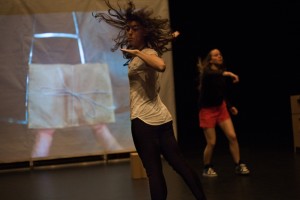When I began touring my latest creation, Gaze is a Gap is a Ghost, I knew that I was setting myself up for some problems and potential failures somewhere along the line. The set-up is time-consuming: in every venue where we perform, we first have to film a 70-minute video of the performance—with full costumes, decor, and lights—and then I have to edit this video, before we actually have the first performance in front of a public. During the filming, the dancers are wearing a point-of-view video camera that records the choreography from the inside perspective of the dance, and this video is later projected simultaneously alongside the live performance.
As you can imagine, it is a complicated set-up, and many things can go wrong along the way. We often have to shoot multiple takes of the same scene in the dance to get the best shot, and it often happens that I am still editing the movie until a few minutes before the live performance.
An important aspect of this film is that it gives the audience the ability to see things on stage that they otherwise wouldn’t be able to see from their seats: the tiny details of various objects and costumes that the dancers interact with. So when we found out that our shipment of material—containing our set, our objects, and our costumes—was stuck in Holland and might not make it to London before the first show, we had to go into immediate problem-solving mode.
The unpredictability was the worst aspect. Would our set arrive in time to make a new film? Would it arrive just before the show? Would it arrive too late? We made three different contingency plans, depending on what time the set actually showed up at the theater.
In the end, the set showed up at 8:00 PM, just when the show was supposed to begin. We quickly assembled it, and the performance went on with an older video that was created in a different venue. (Strangely, that venue, Théâtre de la Bastille had some quite striking similarity of details to the Lilian Baylis Studio…similar dimension, certain pipes and doors and ladders in a similar location.)
Was it ideal to use an older video from a different theater space? No. Did the piece still work? Yes. When I reflect on it, this is kind of how it always feels to present a dance. There are always aspects that fall short of what I imagine to be the ideal version of the piece, and that’s part of what is interesting about live performance.
When we were thinking up the contingency plans, someone brought up the important point that whatever we decided to do should be something that I could defend artistically. That’s true, but at a certain point, don’t we as artists also have to take a kind of leap of faith? We have to just put something out into the world without knowing if it’s completely artistically defensible. During creation, I can often get so much inside my own process, that I don’t really know what I’ve made until after the premiere, or much later. Or perhaps it never happens that I fully know what I’ve made. One has to take the risk and put their work out there before they can know the consequences.
A big thanks to the team at Sadler’s Wells for helping to make the show happen! Once the set arrived, we assembled everything in less than 30 minutes and the show, as it must do, did go on. On the second night, we created a new video for the Lilian Baylis Studio, and it was very interesting to see the two nights consecutively, to see more clearly and specifically the difference between a video from another theater and a video from the same space. My sense is that the video in the actual performance space really allows the audience to go much deeper into the piece. It was good to have this re-affirmation that it is important to follow through with the concept of the piece all the way to the end, and that it does not require us to do a lot of pointless work for nothing!




